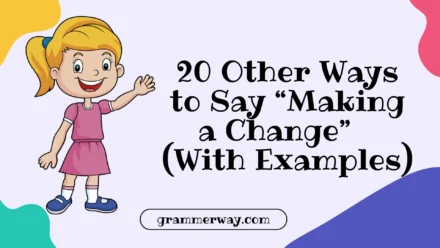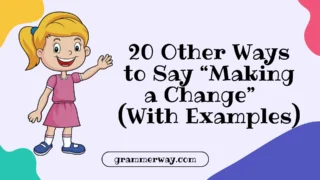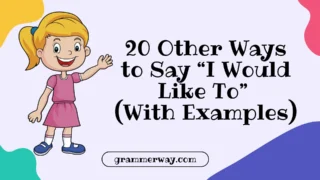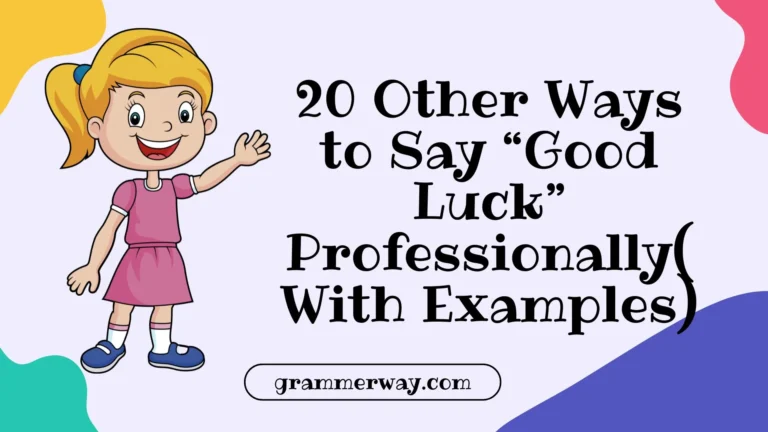When we say “That makes sense,” we often mean that we understand, agree, or connect with what someone is saying. But sometimes, using the same phrase repeatedly can sound mechanical or distant. Finding other ways to say “that makes sense” helps express care, warmth, and empathy in your conversations. By choosing the right words, you can make your message feel more personal, human, and understanding.
What Does “That Makes Sense” Mean?
The phrase “That makes sense” means that you find something logical, clear, or easy to understand. It’s often used to show agreement or comprehension in conversations.
However, depending on the situation, this phrase might come across as neutral or emotionless. Using more empathetic and thoughtful alternatives can help you sound more caring and connected.
Is It Professional or Polite to Say “That Makes Sense”?
Yes, “That makes sense” is both professional and polite in most situations. You can use it at work, in emails, or in personal discussions. However, when you want to sound more genuine, warm, or emotionally present, try using alternatives that show understanding, compassion, or agreement in a deeper way.
These alternatives make your words feel more human and less robotic, helping you build better communication and stronger relationships.
Synonyms for “That Makes Sense”
- I understand what you mean
- I see what you’re saying
- I get it
- That’s true
- I follow you
- I see where you’re coming from
- That adds up
- I can relate
- That’s logical
- I’m with you
- That sounds right
- I hear you
- That’s fair
- I totally get where you’re coming from
- That’s reasonable
- I can see that
- That’s understandable
- I agree with that
- That’s a good point
- I completely understand
1. I Understand What You Mean
Scenario: Use this when someone explains their feelings, frustrations, or a challenging situation.
Meaning: It expresses that you not only heard their words but truly grasp their emotional or logical point.
Tone: Warm, caring, and understanding.
Explanation: This phrase builds emotional connection and shows empathy. It helps people feel validated and supported instead of simply acknowledged.
Examples:
- I understand what you mean—it must have been overwhelming.
- I understand what you mean about balancing work and life.
- I understand what you mean; that situation sounds stressful.
- I understand what you mean; you just want some peace of mind.
- I understand what you mean, and you’re not alone in feeling that way.
2. I See What You’re Saying
Scenario: Use this when someone explains a logical idea, reasoning, or point of view.
Meaning: You’re signaling that their explanation is clear and reasonable.
Tone: Professional, calm, and attentive.
Explanation: This is a great choice for work or thoughtful discussions. It shows you’re listening and processing their point clearly without sounding emotional.
Examples:
- I see what you’re saying; that’s a solid argument.
- I see what you’re saying—it gives me a new perspective.
- I see what you’re saying; that could work better.
- I see what you’re saying, and it makes sense logically.
- I see what you’re saying, and I agree with that approach.
3. I Get It
Scenario: Use this in relaxed, friendly, or supportive conversations.
Meaning: It shows quick understanding, empathy, or connection.
Tone: Casual, kind, and conversational.
Explanation: This phrase is short but powerful. It shows that you relate to the other person emotionally or mentally without sounding too formal.
Examples:
- I get it; things have been really busy lately.
- I get it; sometimes you just need space.
- I get it; you’re tired of repeating yourself.
- I get it; this process can be exhausting.
- I get it; I’ve felt that way before too.
4. That’s True
Scenario: Use this when you agree with someone’s observation or opinion.
Meaning: It acknowledges their statement as accurate or valid.
Tone: Honest, affirming, and warm.
Explanation: This phrase helps build rapport and shows agreement in a friendly way. It can also gently validate someone’s feelings or logic.
Examples:
- That’s true; people often overlook small details.
- That’s true; it’s not easy to stay positive all the time.
- That’s true; communication really does make a difference.
- That’s true; we all need rest sometimes.
- That’s true; your idea could really work.
5. I Follow You
Scenario: Use this when someone is explaining something complex or detailed.
Meaning: You’re keeping up with what they’re saying and you understand the flow.
Tone: Professional, respectful, and attentive.
Explanation: This phrase shows focus and respect, especially in meetings or learning discussions. It reassures the speaker that you’re actively engaged.
Examples:
- I follow you; that plan seems clear.
- I follow you; your logic makes perfect sense.
- I follow you; the data supports your point.
- I follow you; the steps seem practical.
- I follow you; it’s a good approach overall.
6. I See Where You’re Coming From
Scenario: Use this when you want to acknowledge someone’s perspective, even if you don’t completely agree.
Meaning: It means you understand their reasoning or feelings behind their viewpoint.
Tone: Empathetic, understanding, and diplomatic.
Explanation: This phrase helps maintain connection even in disagreement. It’s perfect for emotional or sensitive conversations.
Examples:
- I see where you’re coming from; that must have been difficult.
- I see where you’re coming from; it’s understandable.
- I see where you’re coming from; you just wanted clarity.
- I see where you’re coming from; I might have felt the same.
- I see where you’re coming from; that’s a fair point.
7. That Adds Up
Scenario: Use this when you agree with someone’s logic or reasoning.
Meaning: It means everything fits together or makes logical sense.
Tone: Casual yet confident.
Explanation: This is great for both personal and professional use. It shows understanding and confidence in the other person’s point.
Examples:
- That adds up; your calculations look correct.
- That adds up; it fits the situation perfectly.
- That adds up; the timing explains everything.
- That adds up; I hadn’t thought of it that way.
- That adds up; your reasoning is clear.
8. I Can Relate
Scenario: Use this when someone shares an experience or feeling you’ve been through before.
Meaning: You’re expressing empathy and shared understanding.
Tone: Warm, personal, and supportive.
Explanation: This phrase builds emotional connection and helps people feel seen. It shows that you’re listening not just with your mind, but also with your heart.
Examples:
- I can relate; I’ve been in a similar situation.
- I can relate; it’s hard to manage that pressure.
- I can relate; that kind of stress is real.
- I can relate; I’ve felt that confusion too.
- I can relate; you’re doing your best.
9. That’s Logical
Scenario: Use this in professional discussions or problem-solving contexts.
Meaning: It shows that the reasoning is sound and consistent.
Tone: Formal, analytical, and objective.
Explanation: Perfect for meetings, reports, or debates. It shows respect for someone’s thought process while keeping a professional tone.
Examples:
- That’s logical; it’s the most efficient path.
- That’s logical; the numbers support your claim.
- That’s logical; your plan is well thought out.
- That’s logical; it fits the situation.
- That’s logical; I completely agree.
10. I’m With You
Scenario: Use this to show agreement or emotional support.
Meaning: It means you’re aligned with someone’s thinking or feelings.
Tone: Supportive, warm, and friendly.
Explanation: This phrase builds trust and connection. It’s often used to reassure someone that you’re on their side or agree with them.
Examples:
- I’m with you; that sounds like a fair plan.
- I’m with you; this is the right direction.
- I’m with you; it’s tough, but it’s worth it.
- I’m with you; that makes perfect sense.
- I’m with you; let’s go with that idea.
11. That Sounds Right
Scenario: Use this when someone explains something that aligns with your thoughts or what seems correct.
Meaning: It shows agreement and that you believe what they said is accurate.
Tone: Friendly, confident, and respectful.
Explanation: This phrase is polite and conversational. It’s useful when you want to sound positive and open-minded while agreeing naturally.
Examples:
- That sounds right; it fits what we discussed earlier.
- That sounds right; I remember hearing something similar.
- That sounds right; your reasoning is clear.
- That sounds right; it feels like the right conclusion.
- That sounds right; I think we’re on the same page.
12. I Hear You
Scenario: Use this when someone expresses feelings, frustration, or emotions.
Meaning: It means you’re truly listening and acknowledging their experience.
Tone: Compassionate, gentle, and human.
Explanation: This phrase is emotionally grounding. It helps people feel heard and understood without needing to offer immediate solutions.
Examples:
- I hear you; that situation sounds really stressful.
- I hear you; it’s not easy to deal with that.
- I hear you; you’re doing the best you can.
- I hear you; that must be exhausting.
- I hear you; I’d feel the same way too.
13. That’s Fair
Scenario: Use this when someone makes a reasonable or balanced point.
Meaning: You’re recognizing that their opinion or idea is justified.
Tone: Respectful, calm, and understanding.
Explanation: This phrase conveys open-mindedness. It helps build respect and shows that you’re valuing the other person’s viewpoint.
Examples:
- That’s fair; I can understand your perspective.
- That’s fair; we all have different experiences.
- That’s fair; it’s a reasonable concern.
- That’s fair; I hadn’t thought of it that way.
- That’s fair; let’s consider both sides.
14. I Totally Get Where You’re Coming From
Scenario: Use this in emotional or personal conversations to express deep understanding.
Meaning: You fully understand someone’s reasoning or emotional state.
Tone: Warm, empathetic, and sincere.
Explanation: This phrase goes beyond logic—it connects with emotion. It’s excellent when you want to show care, validation, and genuine understanding.
Examples:
- I totally get where you’re coming from; that must have hurt.
- I totally get where you’re coming from; it’s frustrating.
- I totally get where you’re coming from; I’ve felt that too.
- I totally get where you’re coming from; you just want clarity.
- I totally get where you’re coming from; that’s completely valid.
15. That’s Reasonable
Scenario: Use this when someone presents a logical or balanced idea.
Meaning: It expresses that their idea or approach is fair and makes sense.
Tone: Professional, composed, and polite.
Explanation: This phrase works well in workplaces or calm discussions. It shows that you’re open-minded and appreciative of rational thinking.
Examples:
- That’s reasonable; we can definitely try it that way.
- That’s reasonable; your plan seems practical.
- That’s reasonable; it’s a fair compromise.
- That’s reasonable; I agree with your points.
- That’s reasonable; we can adjust accordingly.
16. I Can See That
Scenario: Use this when you’re acknowledging someone’s idea or perspective thoughtfully.
Meaning: It means you visually or mentally understand what they’re expressing.
Tone: Gentle, reflective, and open.
Explanation: This phrase helps create space for understanding without sounding rushed. It’s especially useful in emotionally sensitive talks.
Examples:
- I can see that; it must have been a tough choice.
- I can see that; it’s clear you’ve thought it through.
- I can see that; your reaction makes sense.
- I can see that; it’s an honest mistake.
- I can see that; I’d probably feel the same.
17. That’s Understandable
Scenario: Use this when someone shares frustration, disappointment, or vulnerability.
Meaning: You’re telling them their reaction or feeling is valid.
Tone: Compassionate, warm, and caring.
Explanation: This phrase comforts others. It helps people feel accepted and reassured that their feelings are normal.
Examples:
- That’s understandable; it was a stressful situation.
- That’s understandable; anyone would feel upset.
- That’s understandable; things have been difficult.
- That’s understandable; you just needed a break.
- That’s understandable; it’s completely fair to feel that way.
18. I Agree with That
Scenario: Use this in conversations where you want to affirm someone’s statement or opinion.
Meaning: You’re expressing agreement or shared understanding.
Tone: Positive, clear, and confident.
Explanation: This phrase is simple yet powerful. It directly communicates alignment and shows that you value the other person’s input.
Examples:
- I agree with that; it’s a smart decision.
- I agree with that; communication really does solve issues.
- I agree with that; we should focus on progress.
- I agree with that; it’s an important perspective.
- I agree with that; your reasoning is spot on.
19. That’s a Good Point
Scenario: Use this when someone says something insightful or worth considering.
Meaning: It acknowledges their contribution as thoughtful or valid.
Tone: Encouraging, kind, and appreciative.
Explanation: This phrase helps others feel valued in discussions. It’s great for teamwork and positive reinforcement.
Examples:
- That’s a good point; I hadn’t thought of it that way.
- That’s a good point; it adds more clarity.
- That’s a good point; we should consider that factor.
- That’s a good point; it could help improve the plan.
- That’s a good point; I really appreciate your input.
20. I Completely Understand
Scenario: Use this when you want to show deep empathy and full comprehension.
Meaning: It means you fully grasp both the logic and emotion behind someone’s words.
Tone: Warm, compassionate, and reassuring.
Explanation: This phrase communicates emotional depth. It reassures others that they’re not alone in their thoughts or feelings.
Examples:
- I completely understand; it’s been a long, stressful week.
- I completely understand; that must have been difficult.
- I completely understand; you did what felt right.
- I completely understand; it’s okay to take your time.
- I completely understand; everyone needs support sometimes.
Conclusion
Finding other ways to say “that makes sense” allows your communication to feel warmer, more human, and emotionally aware. Whether you’re showing empathy, professionalism, or simple agreement, choosing thoughtful phrases helps people feel heard, respected, and understood. Language has power—and when you use it kindly, it connects hearts, not just words.
FAQs
1. Why should I use alternatives to “That makes sense”?
Using alternatives makes your conversations more personal, emotionally intelligent, and engaging instead of repetitive or neutral.
2. Which alternatives are best for professional situations?
Try “That’s reasonable,” “That’s logical,” or “I follow you”—they sound polite, clear, and professional.
3. Which ones show empathy best?
Phrases like “I hear you,” “I understand what you mean,” and “That’s understandable” show real care and emotional awareness.
4. Can I use these phrases in writing?
Yes! These alternatives fit perfectly in emails, messages, and professional communication when you want to sound warm yet concise.
5. How can I remember to use these in real conversation?
Try practicing by replacing “That makes sense” in small moments. The more you use them, the more natural they’ll feel.







Leave a Comment